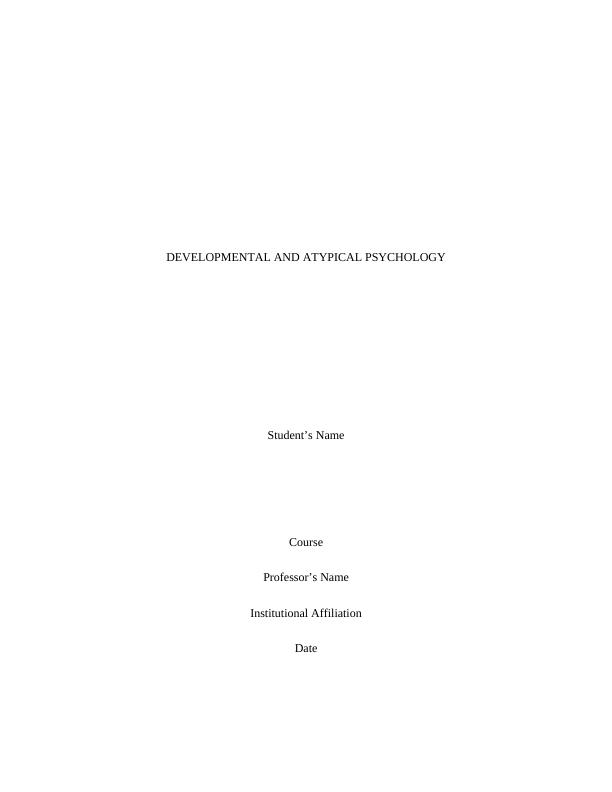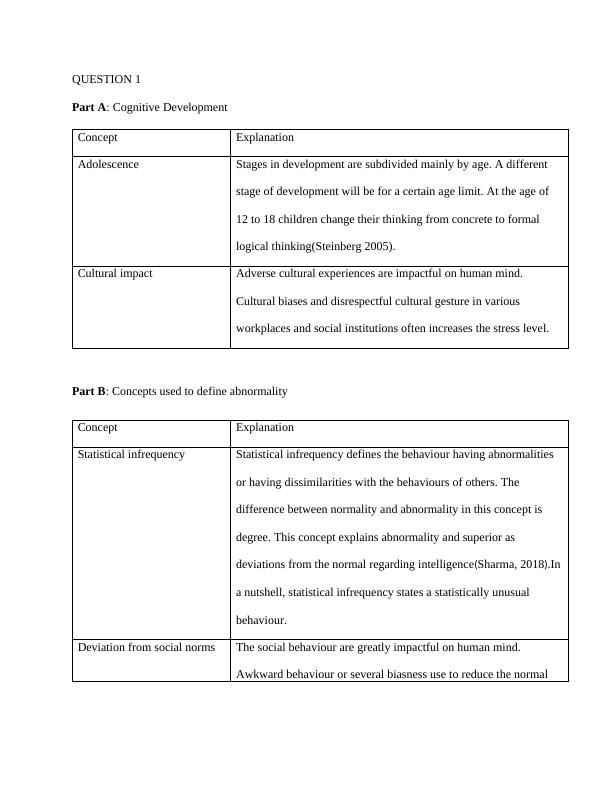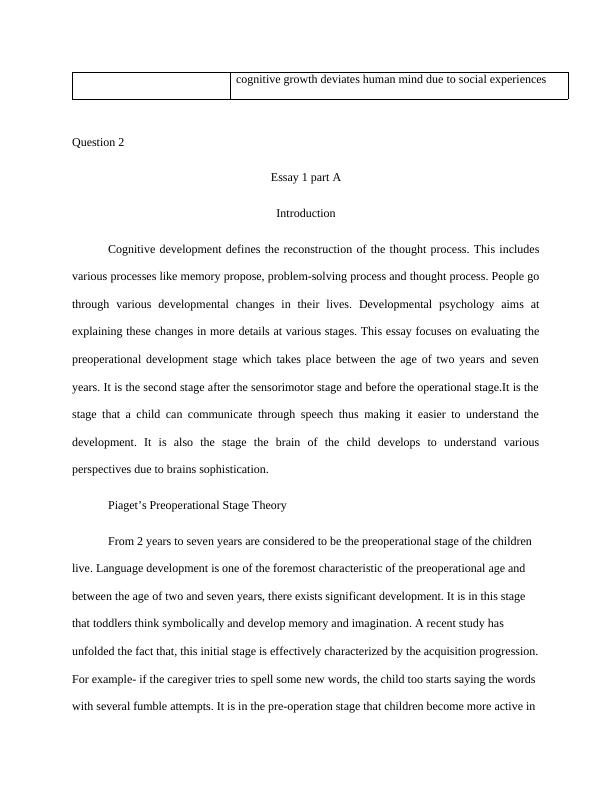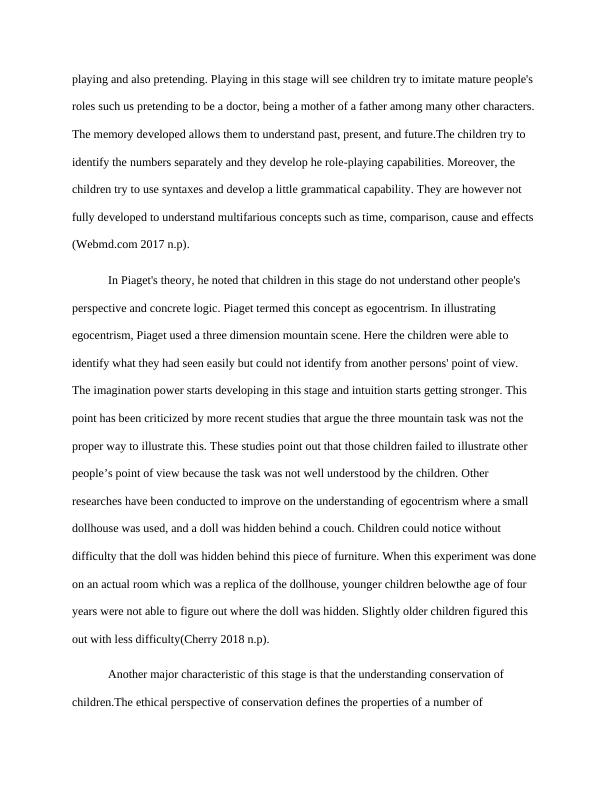Developmental and Atypical Psychology: Cognitive Development and Schizophrenia
Added on 2023-06-03
12 Pages2660 Words60 Views
DEVELOPMENTAL AND ATYPICAL PSYCHOLOGY
Student’s Name
Course
Professor’s Name
Institutional Affiliation
Date
Student’s Name
Course
Professor’s Name
Institutional Affiliation
Date

QUESTION 1
Part A: Cognitive Development
Concept Explanation
Adolescence Stages in development are subdivided mainly by age. A different
stage of development will be for a certain age limit. At the age of
12 to 18 children change their thinking from concrete to formal
logical thinking(Steinberg 2005).
Cultural impact Adverse cultural experiences are impactful on human mind.
Cultural biases and disrespectful cultural gesture in various
workplaces and social institutions often increases the stress level.
Part B: Concepts used to define abnormality
Concept Explanation
Statistical infrequency Statistical infrequency defines the behaviour having abnormalities
or having dissimilarities with the behaviours of others. The
difference between normality and abnormality in this concept is
degree. This concept explains abnormality and superior as
deviations from the normal regarding intelligence(Sharma, 2018).In
a nutshell, statistical infrequency states a statistically unusual
behaviour.
Deviation from social norms The social behaviour are greatly impactful on human mind.
Awkward behaviour or several biasness use to reduce the normal
Part A: Cognitive Development
Concept Explanation
Adolescence Stages in development are subdivided mainly by age. A different
stage of development will be for a certain age limit. At the age of
12 to 18 children change their thinking from concrete to formal
logical thinking(Steinberg 2005).
Cultural impact Adverse cultural experiences are impactful on human mind.
Cultural biases and disrespectful cultural gesture in various
workplaces and social institutions often increases the stress level.
Part B: Concepts used to define abnormality
Concept Explanation
Statistical infrequency Statistical infrequency defines the behaviour having abnormalities
or having dissimilarities with the behaviours of others. The
difference between normality and abnormality in this concept is
degree. This concept explains abnormality and superior as
deviations from the normal regarding intelligence(Sharma, 2018).In
a nutshell, statistical infrequency states a statistically unusual
behaviour.
Deviation from social norms The social behaviour are greatly impactful on human mind.
Awkward behaviour or several biasness use to reduce the normal

cognitive growth deviates human mind due to social experiences
Question 2
Essay 1 part A
Introduction
Cognitive development defines the reconstruction of the thought process. This includes
various processes like memory propose, problem-solving process and thought process. People go
through various developmental changes in their lives. Developmental psychology aims at
explaining these changes in more details at various stages. This essay focuses on evaluating the
preoperational development stage which takes place between the age of two years and seven
years. It is the second stage after the sensorimotor stage and before the operational stage.It is the
stage that a child can communicate through speech thus making it easier to understand the
development. It is also the stage the brain of the child develops to understand various
perspectives due to brains sophistication.
Piaget’s Preoperational Stage Theory
From 2 years to seven years are considered to be the preoperational stage of the children
live. Language development is one of the foremost characteristic of the preoperational age and
between the age of two and seven years, there exists significant development. It is in this stage
that toddlers think symbolically and develop memory and imagination. A recent study has
unfolded the fact that, this initial stage is effectively characterized by the acquisition progression.
For example- if the caregiver tries to spell some new words, the child too starts saying the words
with several fumble attempts. It is in the pre-operation stage that children become more active in
Question 2
Essay 1 part A
Introduction
Cognitive development defines the reconstruction of the thought process. This includes
various processes like memory propose, problem-solving process and thought process. People go
through various developmental changes in their lives. Developmental psychology aims at
explaining these changes in more details at various stages. This essay focuses on evaluating the
preoperational development stage which takes place between the age of two years and seven
years. It is the second stage after the sensorimotor stage and before the operational stage.It is the
stage that a child can communicate through speech thus making it easier to understand the
development. It is also the stage the brain of the child develops to understand various
perspectives due to brains sophistication.
Piaget’s Preoperational Stage Theory
From 2 years to seven years are considered to be the preoperational stage of the children
live. Language development is one of the foremost characteristic of the preoperational age and
between the age of two and seven years, there exists significant development. It is in this stage
that toddlers think symbolically and develop memory and imagination. A recent study has
unfolded the fact that, this initial stage is effectively characterized by the acquisition progression.
For example- if the caregiver tries to spell some new words, the child too starts saying the words
with several fumble attempts. It is in the pre-operation stage that children become more active in

playing and also pretending. Playing in this stage will see children try to imitate mature people's
roles such us pretending to be a doctor, being a mother of a father among many other characters.
The memory developed allows them to understand past, present, and future.The children try to
identify the numbers separately and they develop he role-playing capabilities. Moreover, the
children try to use syntaxes and develop a little grammatical capability. They are however not
fully developed to understand multifarious concepts such as time, comparison, cause and effects
(Webmd.com 2017 n.p).
In Piaget's theory, he noted that children in this stage do not understand other people's
perspective and concrete logic. Piaget termed this concept as egocentrism. In illustrating
egocentrism, Piaget used a three dimension mountain scene. Here the children were able to
identify what they had seen easily but could not identify from another persons' point of view.
The imagination power starts developing in this stage and intuition starts getting stronger. This
point has been criticized by more recent studies that argue the three mountain task was not the
proper way to illustrate this. These studies point out that those children failed to illustrate other
people’s point of view because the task was not well understood by the children. Other
researches have been conducted to improve on the understanding of egocentrism where a small
dollhouse was used, and a doll was hidden behind a couch. Children could notice without
difficulty that the doll was hidden behind this piece of furniture. When this experiment was done
on an actual room which was a replica of the dollhouse, younger children belowthe age of four
years were not able to figure out where the doll was hidden. Slightly older children figured this
out with less difficulty(Cherry 2018 n.p).
Another major characteristic of this stage is that the understanding conservation of
children.The ethical perspective of conservation defines the properties of a number of
roles such us pretending to be a doctor, being a mother of a father among many other characters.
The memory developed allows them to understand past, present, and future.The children try to
identify the numbers separately and they develop he role-playing capabilities. Moreover, the
children try to use syntaxes and develop a little grammatical capability. They are however not
fully developed to understand multifarious concepts such as time, comparison, cause and effects
(Webmd.com 2017 n.p).
In Piaget's theory, he noted that children in this stage do not understand other people's
perspective and concrete logic. Piaget termed this concept as egocentrism. In illustrating
egocentrism, Piaget used a three dimension mountain scene. Here the children were able to
identify what they had seen easily but could not identify from another persons' point of view.
The imagination power starts developing in this stage and intuition starts getting stronger. This
point has been criticized by more recent studies that argue the three mountain task was not the
proper way to illustrate this. These studies point out that those children failed to illustrate other
people’s point of view because the task was not well understood by the children. Other
researches have been conducted to improve on the understanding of egocentrism where a small
dollhouse was used, and a doll was hidden behind a couch. Children could notice without
difficulty that the doll was hidden behind this piece of furniture. When this experiment was done
on an actual room which was a replica of the dollhouse, younger children belowthe age of four
years were not able to figure out where the doll was hidden. Slightly older children figured this
out with less difficulty(Cherry 2018 n.p).
Another major characteristic of this stage is that the understanding conservation of
children.The ethical perspective of conservation defines the properties of a number of

End of preview
Want to access all the pages? Upload your documents or become a member.
Related Documents
Types of Assessments Among School-Aged Childrenlg...
|5
|1110
|314
Developmental Theories of Different Ageslg...
|5
|693
|193
HEALTH AND WELLBEING ACROSS THE LIFESPANlg...
|6
|1430
|53
Psychology of Child Development Assignmentlg...
|7
|1590
|12
Cognitive Development: Piaget's Theory and Educational Implicationslg...
|9
|1721
|462
Cognitive Development: Piaget's Theory and Stageslg...
|5
|1052
|43
